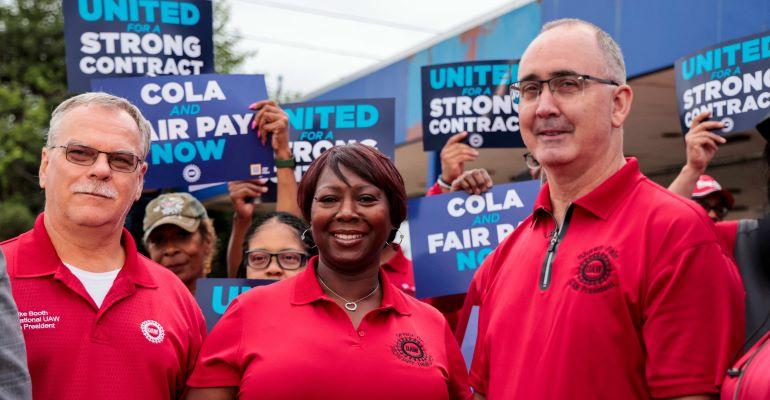The chief of the UAW has been playing a rougher version of contract negotiations than his predecessors. The reason is that he sees this year’s contract talks perhaps the last best chance to get what the union has wanted for the past 20 years.
Thus, he is pushing for a strike vote from members and is even threatening to strike all three Detroit automakers simultaneously, which the union has never done.
The biggest reason that would be unusual and difficult is it would quickly deplete the UAW’s strike fund used to support striking workers, says Patrick Anderson, CEO of Anderson Economic Group, which tracks issues between unions and management.
Four years ago, the UAW struck General Motors for more than 40 days. The cost to GM turned out to be almost $2 billion. But conditions today are far different, and any strike lasting more than two weeks would be very costly to all concerned. That’s because today’s inventory level of about 55 days is one-fifth the level the industry was facing in 2019. A strike today would deplete Detroit Three vehicle stores quickly.
A 10-day strike, for example, against all three automakers could result in $5 billion in economic losses, according to Anderson’s analysis. That estimate includes union wage losses of $795 million and OEM losses of $1.2 billion, as well as the losses incurred by automotive suppliers, dealers and industry. The losses compound if such a strike were to extend several more weeks.
The Industry Resetting
The auto industry is going through the most profound transition it has experienced since the days of Henry Ford and the advent of the assembly line. Anderson, who briefed media this week, says if the union makes good on a threat it has recently made to strike GM, Ford and Stellantis all at once, instead of choosing one automaker for a strike, the economic impact would be worse than past strikes, on consumers and dealers, as well as the states where UAW factories operate. It also would be tougher on the union to sustain.
“That’s why I would not expect it,” he says. If the union strikes, he says, it would be on Stellantis, which is the company the union has been bargaining with for a “pattern” agreement that GM and Ford would be expected to sign on to as well.
UAW President Shawn Fain has set a particularly combative tone thus far in negotiations. He skipped the symbolic handshake with Stellantis CEO Carlos Tavares when the union’s negotiations kicked off in July, and he recently recorded a YouTube video in which he threw that automaker’s most recent offer into the garbage. That kind of showmanship and use of social media has not been a part of the union’s strategy in the past.
“The rhetoric has been very bombastic,” notes Anderson. “These negotiations are proving very different and difficult, compared with past contract talks.”
"We are 30 days away and the clock is ticking," Fain said this week in a livestream to members, referring to the end of the current contract. "This is our generation’s defining moment, and make no mistake management’s watching. The (Detroit Three) CEOs are watching, the White House is watching."
Indeed, President Biden, who is running for re-election in 2024, wants neither a strike on his hands nor a risk of losing the UAW’s endorsement and the union’s “get-out-the-vote” efforts that come with it. Biden, who often touts his union support in contrast with Republicans, is fortunate that the Teamsters and UPS averted a strike last month, which Anderson said would have been much more significant and detrimental to the national economy than a potential UAW strike.
The UPS deal with the Teamsters in part has fueled the UAW’s rancor and demands as the union got virtually everything it wanted, including the end of a 2-tiered pay system for drivers.
The UAW has been pushing for a 46% wage hike over four years -- with 20%of that coming upfront, blaming recent inflation. It wants more paid time off, higher retiree pay and healthcare benefits for retirees. Like the Teamsters deal, the union also wants an elimination of the current 2-tier system for employees on wages and benefits that treats newer employees different than established employees.
An analysis by Bloomberg says if the three automakers agreed to all the union’s current demands, it would cost them about $80 billion collectively over the next four years.
The BEV Era Is Here
Autoworkers are particularly concerned about how the shift to battery-electric vehicles could threaten their jobs and compensation over the next decade, as the federal government is pushing automakers to make two-thirds of new-vehicle sales BEVs by 2032.
The impact of BEVs on auto manufacturing is still hard to assess. But what we do know is that BEVs, which are heavily software-based and less complex to build, require new and substantially retooled factories manned by fewer workers. Estimates are that BEVs require 30% less labor to assemble than internal-combustion-engine vehicles, and the lower demand for labor may be more depending on the level of automation that is dialed into the new production lines. BMW, for example, has said it will reduce workforce through attrition and reskilling during the BEV era, but has not been specific on numbers.
But Stellantis last May, just ahead of negotiations, announced an offer of voluntary buyouts to to more than 33,500 hourly and salaried employees, a response, the company said, to an increasingly competitive auto market and the expensive shift to electrification. The buyout packages are available to 31,000 hourly workers in the U.S. and Canada. The UAW’s Fain called the cuts “disgusting.”





